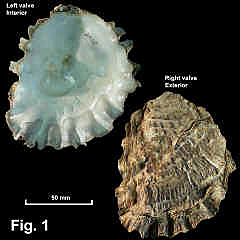|
|
OSTREIDAE |
|
|
|
Magallana gigas (Thunberg, 1793) Pacific Oyster Description: Shell solid, heavy or light. Shape variable from roughly circular to elongate. Lower (left) valve cup-shaped, adherent to substrate and conforming to the surface, upper (right) valve concave, flat or convex. Hinge short. Interior white, muscle scars white or pale yellow, occasionally with purple patches; margins without chomata. Exterior surface chalky, irregularly crumpled, margin crenulate. Shell colour chalky white or cream with purple or reddish streaks. Size: Up to 400 mm in length, but usually up to 150-200 mm in NSW. Distribution: Native to the north-west Pacific region, including Korea, Japan and Russia. It has been introduced to all continents except Antarctica for aquaculture and has naturalised widely. In Australia, it is now known in the wild from Moreton Bay, Qld, southwards to Tasmania and SA. Habitat: Intertidal and subtidal on rock, gravel and mud substrates in bays and estuaries. Comparison: This species is found in estuaries along with Saccostrea glomerata (Sydney Rock Oyster), and when small it is difficult to separate the two species. Magallana gigas can be separated on size, because it grows much larger than S. glomerata - up to 400 mm in length for M. gigas as opposed to 100 mm in S. glomerata. The most obvious and reliable differentiating shell character is the smooth interior margin of the shell, in contrast to that of S. glomerata with chomata. Synonymy: Previously known as Crassostrea gigas (Thunberg, 1793). Remarks: This is the Pacific Oyster, which is now cultivated in aquaculture systems in Australia and worldwide. It was first introduced into Australia for aquaculture in 1947. Spat attached to oyster and scallop shells from China and Japan were planted at Oyster Harbour, WA, and Pittwater, Tasmania (Wolf & Medcof, 1973). The spat at Oyster Harbour all died, but those at Pittwater survived and spawned over the following years. In 1952, a further import from Hiroshima, Japan, was placed in Pittwater, and those spat survived well. In 1955 some of the Pittwater oysters were moved to Port Sorell in northern Tasmania and the others were moved to Mallacoota in Victoria. The species subsequently spread throughout northern Tasmanian estuaries. By 1973 the species had spread to southern NSW estuaries. By 2010 Pacific Oysters occurred in all NSW estuaries south of the Hastings River. Due to very high densities of Pacific Oysters in Port Stephens, Pacific Oyster culture has been permitted there since 1990, but it is not permitted elsewhere. Following the impact of OX disease on cultivated Sydney Rocks, the farming of functionally sterile triploid Pacific Oysters is enabled under permit in the Georges River and Hawkesbury River. Trial cultivation of triploid Pacific Oysters is also underway in a number of other NSW estuaries (NSW Department of Primary Industry, 2023). The aquaculture of this species worldwide is described by the Smithsonian Environmental Research Center (2024). Magallana gigas is commonly known as the Pacific Oyster and is native to the Northwest Pacific including Russia, China, and Korea. It is the most widely cultivated and harvested shellfish species in the world, introduced to at least 52 countries. It has established breeding populations in the Northeast Pacific (US-Canada), Southwest Pacific (Australia-New Zealand), Northeast Atlantic-Mediterranean (Europe), Southwest Atlantic (Argentina-Brazil), and Indian Ocean (South Africa). In introduced locations, M. gigas often starts by being confined to the immediate areas of cultivation with only sporadic and limited reproduction, but later it spreads and becomes a major biomass component and ecosystem engineer. This process, which has taken 3-10 decades, has occurred in British Columbia, Washington, the North Sea, the Atlantic coast of Patagonia, Hawaii, and Australia. Fig. 1: Hastings Bay, Southport, Tasmania. (C607718, reregistered from DLB3048) |
|
